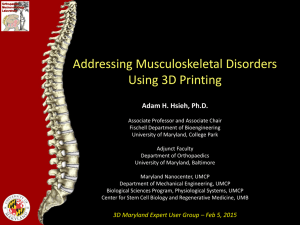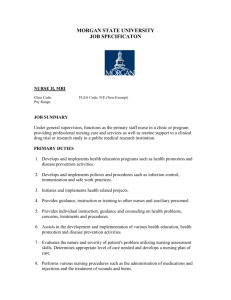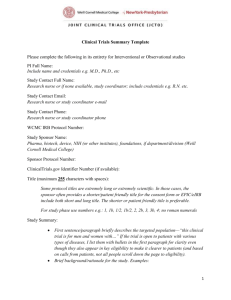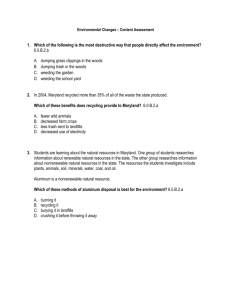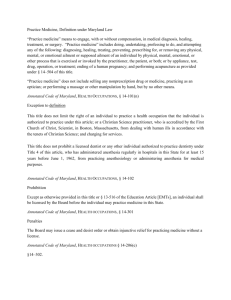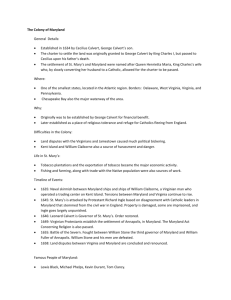Getting the Most Out of Assertive Community Treatment (ACT)
advertisement
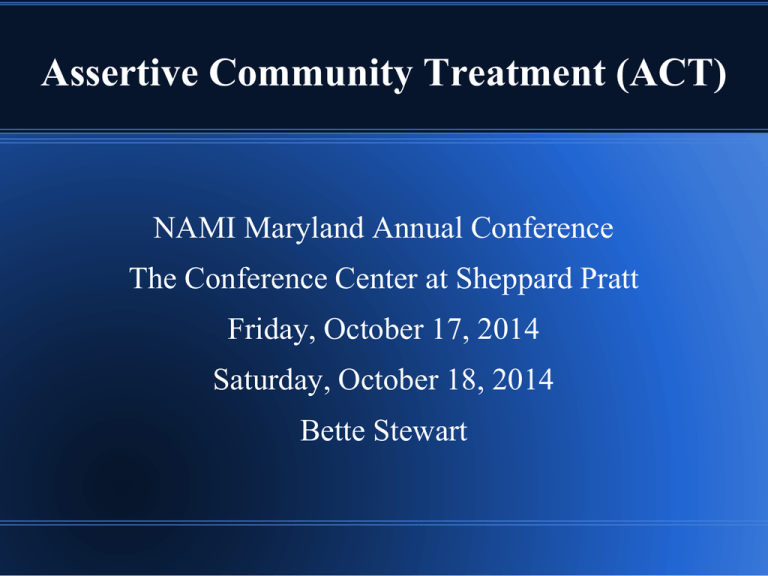
Assertive Community Treatment (ACT) NAMI Maryland Annual Conference The Conference Center at Sheppard Pratt Friday, October 17, 2014 Saturday, October 18, 2014 Bette Stewart Goals for Today ● Describe who is appropriate for ACT services ● Describe basic principles of ACT services ● ● ● Describe how ACT services differ from Case Management Services Describe history of ACT and how ACT has evolved over 40 years Describe how to access ACT services in your community The Who, What, Where, Why & How ● Who does ACT serve? ● What do ACT services look like ? ● Where did ACT begin and where is it now? ● Why is Maryland a supporter of ACT? ● How do we know it’s ACT? WHO is appropriate for ACT? ● Individuals with: – Severe and persistent mental health conditions (schizophrenia, bipolar and schizoaffective disorders) – High users of institutions ● Inpatient psychiatric beds ● Jail/prison ● Crisis stabilization WHO is appropriate for ACT? ● ● ● Individuals for whom traditional mental health services have not adequately engaged the person in treatment Homelessness Significant difficulty doing the everyday things needed to live independently in the community WHO determines eligibility? ● ● ● Eligibility is based on the previous criteria Referrals come from inpatient units, emergency rooms, outpatient clinics, community at large, detention centers, mental health courts, and yes, from families A licensed mental health clinician meets with the individual to complete an evaluation to determine if that person meets eligibility criteria WHAT are ACT Team Staffing Requirements ● ● ● ● A full-time licensed clinical mental health worker (social worker, licensed professional clinical provider, masters level nurse, psychologist, etc.) A prescriber (psychiatrist or psychiatric nurse nurse practitioner) Nurses Employment Specialists WHAT are ACT Team Staffing Requirements ● Substance use specialists ● Peer counselors ● Case managers ● Counselors / Therapists WHAT are the ACT Core Principles? ● Small caseloads, with a ratio of 1:10 ● Team approach ● 24/7 access to a team member ● Assertive engagement skills and approaches ● Working with families ● Service provision in the community ● Recovery focused WHAT do ACT services look like? ● ACT is different than Case Management ● ACT operates as a Transdisciplinary Team ● – Interdisciplinary team – Multidisciplinary team WHAT guides ACT services? Case Management v ACT ● ● ● Case Management is time limited Case Management refers individuals to existing community resources Case Managers have their own case load of clients the are responsible to serve Case Management v ACT ● ● ● ACT services are time unlimited ACT provides all services without brokering to other providers (except for services they are not equipped to handle, such as somatic care, physical therapy, etc.) ACT functions as a team with every staff member familiar with every client ● Multidisciplinary ● Interdisciplinary ● Transdisciplinary WHO does WHAT? ● Specialists ● Generalists ● Working as a Team – Different discipline perspective – Continuity of care – Meeting clinical and rehabilitative needs – Sharing responsibility – Decreasing staff-burnout WHAT ACT services include: ● Person-centered approach to service delivery ● Access to multiple levels of care ● A strong focus on wellness and recovery ● Help finding and keeping employment ● Assistance with substance use ● Finding and maintaining (keeping) housing ● Finances (accessing benefits, budgeting, explaining how work will affect benefits, etc.) WHAT ACT services include: ● Self-management skill development ● Medication management ● ● Attention to and coordination of care for other medical needs Building a community network of support for the individual HOW do we know ACT is effective? ● Evidence-based Practice ● Research outcomes ● – Decreased hospitalizations and incarcerations – Improved housing stability, quality of life, client satisfaction, and vocational outcomes FOLLOW THE MODEL TO GET THE ROBUST OUTCOMES SEEN IN THE RESEARCH! WHAT guides ACT services? ● ● ● Code of Maryland Regulations (COMAR) 10.21.19.01 Fidelity Assessments by the Behavioral Health Administration Monitors – DACTS – TMACT Model adherence tied to reimbursement rate HOW did ACT start and WHY continue with ACT? ● ● ● ● Mendota State Hospital; Madison, WI From “Training in Community Living”, to “Hospital without Walls”, to a Recovery Model of Care Hospitals are charged with getting the person back to the community People may need hands on support and side-by-side supports to be successful Maryland ACT Teams ● Anne Arundel ● Lower-Shore ● Baltimore City ● Mid-Shore ● Baltimore County ● Montgomery County ● Frederick County ● Prince George's County ● Harford County ● Washington County ● Howard County ● ● THANK YOU FOR CHOOSING MY WORKSHOP TODAY! FOR QUESTIONS OR WANT ADDITIONAL INFORMATION PLEASE CONTACT ME, BETTE STEWART AT ● bstewart@psych.umaryland.edu ● 410-646-5181
